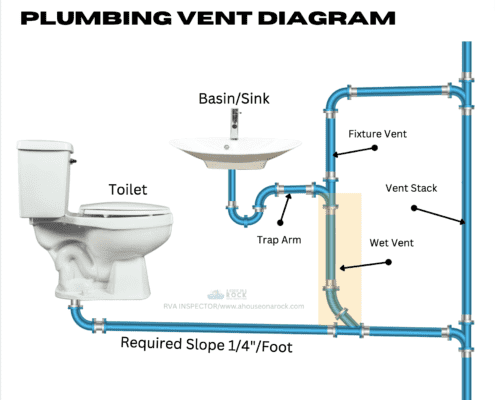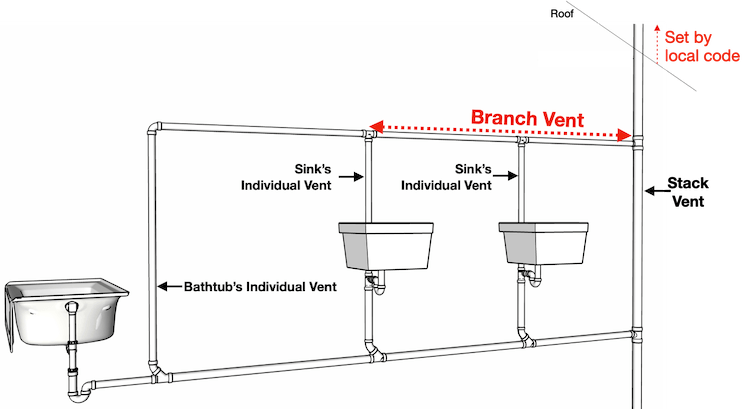This great article down the page on the subject of The Upsides of Proper Ventilation in Plumbing Design is exceptionally insightful. Don't miss it.

Appropriate ventilation in plumbing systems is frequently neglected, yet it is critical for preserving the functionality and security of your home's pipes. Air flow aids manage atmospheric pressure, protect against the buildup of dangerous gases, and ensure the efficient elimination of waste. In this overview, we will certainly check out the importance of proper pipes ventilation, just how it functions, and the advantages it brings to your pipes system.
How Air Flow Functions in Pipes Systems
Air Pressure Policy
Correct air flow keeps balanced atmospheric pressure within the plumbing system. When water flows through pipelines, it displaces air. Without appropriate ventilation, this variation can produce negative pressure, causing slow drains or siphoning of water from traps, which can cause undesirable smells to seep into the home.
Avoiding Sewer Gas Buildup
One of one of the most critical features of plumbing vents is to avoid drain gases, such as methane and hydrogen sulfide, from accumulating within the home. These gases can pose significant health and wellness dangers and are highly combustible. Vent pipelines allow these gases to get away safely outdoors.
Assisting in Waste Elimination
Ventilation aids in the efficient removal of wastewater by preventing airlocks in the water drainage system. When air can move openly with the vents, it permits water and waste to move smoothly via the pipes, reducing the threat of clogs and backups.
Benefits of Proper Ventilation
Improved System Effectiveness
Properly ventilated plumbing systems operate much more effectively, with fewer clogs, faster draining, and less strain on the pipelines. This performance expands the life-span of the plumbing system.
Improved Air Top Quality
By preventing sewage system gases from entering your home, correct air flow contributes to far better interior air high quality, making your living environment healthier and extra comfortable.
Stopping Water Damages
Appropriate air flow helps avoid water from being siphoned out of traps, which can lead to drain gases going into the home and creating water damage gradually.
Steps to Guarantee Appropriate Ventilation
Consulting Plumbing Codes
Constantly consult neighborhood plumbing codes when designing or modifying your plumbing system. These codes provide the required standards for proper airing vent and ensure your system fulfills safety and security requirements.
Normal Inspection and Upkeep
Regular inspections can help determine potential ventilation problems before they end up being significant issues. Upkeep tasks, such as cleaning up vent pipes and checking for clogs, are necessary for maintaining the system in good working order.
Specialist Setup
For new installations or significant modifications, it's wise to work with a specialist plumbing professional. They have the knowledge to ensure the air flow system is correctly made and set up according to code.
Understanding Air Flow in Plumbing
Air flow in pipes describes the network of pipes that enable air to move with the water drainage system. These vents serve numerous functions, consisting of regulating air pressure within the pipelines, preventing drain gases from getting in the home, and helping in the smooth circulation of wastewater.
Types of Pipes Vents
Key Heap Vent
The primary pile vent, also referred to as the air vent pile, is the key vent in a pipes system. It expands from the major drainpipe align with the roofing, allowing gases to run away and fresh air to get in the system.
Branch Vent
Branch vents attach to the primary stack air vent and offer individual fixtures, such as sinks, bathrooms, and showers. These vents guarantee that each component has adequate air flow to function properly.
Air Admission Valve (AAV).
An Air Admission Shutoff (AAV) is a one-way shutoff that permits air to get in the pipes system without the requirement for a conventional vent pipeline prolonging through the roof covering. AAVs are typically made use of in improvements or areas where installing a typical vent is not practical.
Signs of Poor Air Flow in Pipes.
Slow Draining Fixtures.
If your sinks, tubs, or commodes are draining gradually, it could be an indicator of bad air flow. Insufficient air circulation can create a vacuum impact, making it tough for water to drain pipes appropriately.
Gurgling Appears.
Gurgling sounds originating from drains are usually a result of air being drawn through water traps due to negative pressure in the pipes. This is a clear indicator of insufficient ventilation.
Unpleasant Odors.
Sewage system smells inside your home are a warning that your plumbing system is not correctly ventilated. This could suggest that sewer gases are not being sufficiently aired vent outside, bring about possibly harmful problems.
Common Ventilation Mistakes.
Insufficient Vent Sizing.
Using undersized air vent pipelines can bring about bad air circulation and stress discrepancies in the system. It's vital to make use of vents that fulfill the particular needs of your plumbing system.
Improper Vent Placement.
Putting vents too much from the components they offer can decrease their effectiveness. Appropriate placement ensures that air can stream openly and effectively via the system.
Disregarding Code Requirements.
Building ordinance offer certain guidelines for plumbing air flow. Ignoring these codes can lead to a system that fails to function properly and might result in expensive fixings or health hazards.
Final thought.
Appropriate ventilation is a vital element of any type of plumbing system, guaranteeing that it works efficiently and safely. By understanding the relevance of air flow, acknowledging the signs of poor air flow, and taking steps to preserve your system, you can avoid expensive concerns and secure your home's air high quality.
4 Things You Should Know About Your Plumbing Vents
What Plumbing Vents Are
Also called a vent stack, a plumbing vent is a vertical pipe attached to your drain line that runs through your roof. The plumbing vent pipe, or plumbing air vent, removes gas and odors from your plumbing system and allows fresh air to enter the pipes, helping the water to flow out of the drain pipes.
What Plumbing Vents Do
Plumbing vents have two basic functions. One of which is to allow unpleasant smelling wastewater and sewer gasses to escape your plumbing system instead of entering your home. Plumbing vent pipes are typically located on roofs, away from windows, to ensure the fumes exit the home completely.
The other function of the plumbing vent is to move fresh air into your plumbing system. This helps move water through every plumbing fixture in your house, like toilets and sink drains. Think of the way in which you need to let a little air into the bottle as you pour soda in order to make the drink flow smoothly.
Different Types of Plumbing Vents
- True vent: This is the most common vent option. In simplest terms, a true vent is a vertical pipe attached to your drain line that exits through the roof. They often function as the main vent that other fixtures can connect to.
- Re-vent pipe or auxiliary vent: Attached to the drain line near specific plumbing fixtures, re-vent pipes run up and over to connect to the main vent.
- Common vent: Two plumbing fixtures installed on opposite sides of a wall are typically tied into the vent stack using something known as a sanitary cross.
- Wet vent: This venting option operates as a drain pipe and a vent at the same time. Wet vent drainage systems drain water from one fixture while venting the air from another. Although they’ve been used for over 100 years, wet vent systems have only recently been added to the plumbing code in many areas. If you’re planning on installing one in a bathroom remodel, make sure you check your local code prior to construction.
- Loop vent: For free-standing fixtures like kitchen island sinks, loop vents are ideal. These vent pipes run under the floor, rise from the P-trap, and create a loop inside the cabinet sink.
- Air admittance valve: An AAV is a one-way mechanical valve typically installed at the site of the plumbing fixture. AAVs allow venting to occur without having to tie into a larger venting system. They’re ideal for venting fixtures where you aren’t able to easily connect to an existing vent system.
Common Plumbing Vent Issues
Although vent pipes typically don’t have water flowing through them, they’re still subject to many typical plumbing issues. For example, clogs are one of the most common problems associated with sewer vent pipes. If your vent pipe gets clogged, all of your plumbing fixtures tied into the vent stack will be affected.
A sink with a slow drain that bubbles and gurgles or a strong sewage smell around your toilet are both indicators that your toilet vent pipe is clogged. Because most vent pipes exit through the roof, old leaves, twigs or even a bird’s nest could be clogging the pipe.
Clogs in your vent pipe system cause a buildup of negative pressure, meaning that water won’t be able to flow out of your home very well. It’s similar to putting your finger over the opening of a straw to trap water inside. When you remove your finger, the water is able to flow out of the straw.
If you suspect you have any blockage in your vent, make sure you have a professional come examine the situation. Left unchecked, a blocked air vent can lead to other costly repairs, like leaks and sediment buildup.
Under Pressure
Pipe vents are essential aspects of a home’s plumbing system. Owning a home means learning about all sorts of things you never put much thought into before. But by understanding as much as you can about the important systems of your home, you can keep those budgets intact and those anxiety levels low.
https://www.homeserve.com/en-us/blog/home-improvement/plumbing-vents/

As a passionate person who reads about What Is A Plumbing Vent & How Do They Work?, I figured sharing that excerpt was beneficial. Are you aware of someone else who is very much interested in the topic? Please feel free to promote it. Thank you so much for going through it.
Book Service Now
Comments on “The Reasons Why Adequate Ventilation is Crucial for Plumbing Systems”